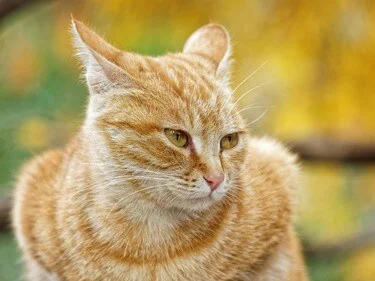Cats are emotive creatures. They are expert communicators and use various tactics to ‘speak’ to humans and animals. Besides body language and vocalizations, cats convey what they’re thinking and feeling through their ears. Each ear position has a different, universal meaning that you can use to ascertain your cat’s mood.
Cats can swivel their ears up to 180 degrees and adopt many different ear positions. A cat with its ears facing forwards is happy, relaxed, and contented. If a cat’s ears point straight up, it is alert and curious about what’s going on around it. Ears turned back or sideways indicate that a cat is feeling scared or anxious. Cats with their ears low and facing out are likely to be feeling unwell. If a cat has one ear folded or down, it’s feeling confused and unsure of what to make of its situation.
If you want to understand what your cat is thinking and feeling, start with its ears. Coupled with a cat’s posture and body language, the ears are very useful for understanding what cats want and need from you.
Cat Ear Positions And What They Mean
Cats have 32 muscles in each ear, which is 5 times the number that humans have. These muscles help cats hear high-frequency sounds and enable them to swivel their ears 180 degrees, giving them a wide range of motion.
Understanding what each ear position means can determine what your cat is trying to tell you. These are the most common explanations for a cat’s ear positions:
Ears Faced Forward
Ears facing forwards is known as the neutral position. If your cat’s ears are doing this, it feels relaxed, content, and playful. When your cat displays its ears in this position, it’s in its most friendly mood. It is the time when you are most likely to get away with picking your cat up and cuddling it.
Some cats won’t allow this, even if they’re in a good mood. Whether a cat allows you to touch it or not is down to its personality. For example, if your cat has never enjoyed being picked up, its happy, positive attitude won’t change anything. Instead, focus on playing with your cat in the way it enjoys.
Even if your cat is relaxing in its favorite spot, you’ll find that your cat’s ears will always twitch as it stokes out its surroundings. At the very least, the ears will remain alert. They may also swivel continuously as your cat tracks the noises it hears.
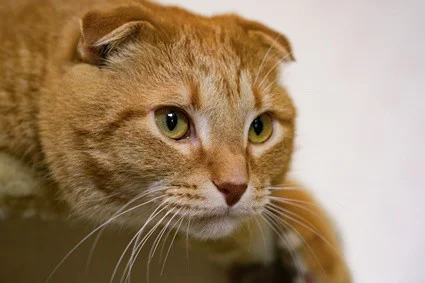
Ears Straight Up
A cat with its ears straight up is alert and interested in what’s going on in its surroundings. With its ears in this position, a cat will try to determine what is happening in its immediate vicinity by listening to the unique and unfamiliar noises and working out what they are.
Curious cats who are interested in something they’ve seen might swivel their ears from side to side to home in on the noise. Cats that enjoy watching birds out of the window are most likely to adopt this ear position, as are guard cats that regularly patrol the house.
Cats have excellent hearing, so even if humans can’t hear what a cat can hear, it’s worth heeding a cat’s warning in case of intruders or other dangers. Otherwise, your cat is simply enjoying itself by watching the world go by.
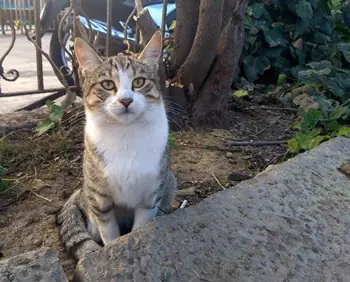
Ears Turned Back or Sideways
A cat with its ears in a backward or sideways position is feeling scared or anxious. As a result, the cat may become aggressive as it tries to deal with its fear. You’ll be able to tell for sure by looking at its pupils. Cats with large, black pupils and back or sideways ears are feeling fearful. They are preparing to fight or flee.
Often, pinned back ears will be accompanied by a crouched body posture and excessive vocalization. Scared cats might also swipe or scratch as a human tries to get close. Giving a nervous cat space to calm down is wise. If a cat feels smothered, it may lash out with aggressive behavior. This can surprise many owners if their cats are usually calm.
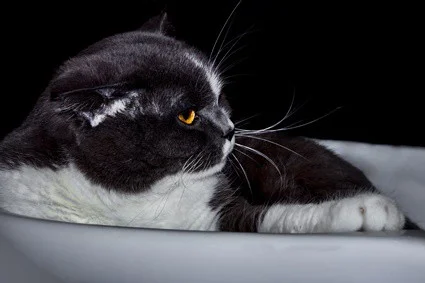
Ears Low And Facing Out
A cat with its ears in this position may be feeling unwell. As described in Sage Journals, cats are descendants of solitary animals, where hiding illness is vital for survival. Therefore, domestic cats display few signs of distress.
Fortunately for owners, cats that keep their ears low and facing outwards are giving away that they are unwell, albeit unwittingly. To be sure, pay close attention to your cat’s overall behavior and attitude for any changes or signs of distress. If your cat hides away or refuses to eat, health issues are almost certainly to blame.
All cats get health issues from time to time, including bad stomachs or mild sickness. This is normal, and your cat needs time to recover or heal.
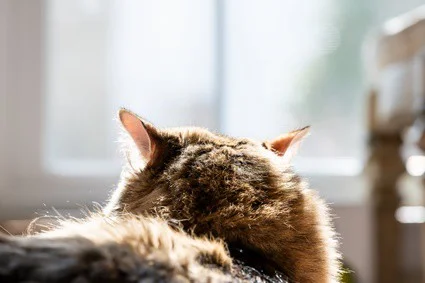
One Ear Down
If your cat has one ear folded down or its two ears are doing different things altogether, your cat feels confused or unsure. Your cat may be trying to focus on more than one thing or is trying to decide what it thinks of the situation it is in, particularly if it’s experiencing something new.
If you’ve recently moved home or introduced a new pet to the home, this ear position is typical. Once your cat has made up its mind, its ears will prick up, and it will become more alert.
However, your cat might be placing one ear down because it’s injured or has an ear infection. Bacterial and yeast infections are the most common. A cat will fold one ear down because of discomfort to prevent humans from getting near the ear canal.
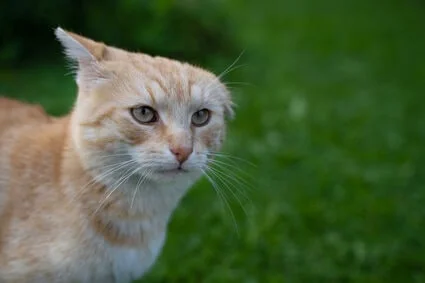
Why Are My Cat’s Ears Twitching?
While technically not a position, a cat’s twitching ears indicate that your cat is agitated. Because of their amazing hearing, they may be picking up on something that you aren’t. Twitching allows cats to capture the surrounding noise they hear by manipulating their ears into the optimal shape.
Hissing and pouncing may follow the ear twitching as your cat adopts aggressive behaviors. These behaviors are usually a reaction to feeling scared of something. Similarly, if your cat’s ears twitch and fold flat against the head, it is unhappy. Reassuring your cat or providing it with some space will help it to feel comfortable once again.
Twitching can also be a reaction to ear mites, fleas, cuts, stings, or polyps.
Main Functions of the Ear
As described by the MSD Veterinary Manual, the ear is an organ of hearing and balance. It consists of the outer, middle, and inner ear.
The outer ear is made up of the ear canal and the pinna. The pinna is the part of the ear that sticks out. It’s made of cartilage and is covered in skin, fur, and hair. Its primary function is to capture sound waves and funnel them into the eardrum through the ear canal. Interestingly, the pinna on their ear can move independently of each other.
A cat’s ear canal appears deep within the ear and is prone to dirt and wax build-up. The ear canal is an effective funnel for driving sound into the eardrum.
The middle ear consists of the eardrum and the hammer, anvil, and stirrup. These are three tiny bones that are contained in an air-filled chamber. Inside the middle part of the ear are two muscles; the oval window and the eustachian tube. This tube connects the middle ear with the back of the nose, allowing air to enter.
The inner ear is the most complex of the three. It includes the cochlea, which is known as the hearing organ, and the vestibular system. This is the organ of balance. For a cat to maintain its balance, the inner ear’s semi-circular canals are filled with fluid. These canals give cats their agility and balancing skills.
Other Forms of Cat Communication
It’s not just their ears that cats communicate with. Cats use various methods to communicate with humans and other animals, including sounds, posture, and body language. Some are human-specific, while others are universal.
These forms of communication are vital to cats, who rely on them to survive in the wild and protect themselves from harm. They also allow animals to bond with humans and alert them to fulfill their basic needs. Once you understand how cats communicate, it’s easy to see what they want and need. These are the most common that cats use:
Body Language
A cat’s body shape and posture offer insights into how your cat is feeling. A happy cat will stand in a relaxed body posture with its tail slightly curved at the tip. The ears will adopt a neutral position, and its mouth will remain closed.
Similarly, a cat that lays down with its stomach exposed is showing its contentedness. It doesn’t sense any nearby dangers and knows you are not a threat. Cats with their stomachs exposed are vulnerable and don’t adopt this position unless they are confident you will not cause it any harm.
A worried cat will adopt a crouched position. Its muscles will be tense, and its tail will be tucked tightly into the body, safely away from danger. A nervous cat will position its ears sideways, and its pupils will dilate.
In this position, your cat is getting ready to run away from danger, so it will hold its body tight to enable a quick reaction. Many scared cats will tuck themselves away in spots that no one can reach and won’t reappear until the danger subsides.
An angry cat will adopt two clear positions. The first position will be to lay down flat to the floor, with its ears flattened and pupils dilated. The rail will be held tightly to the body, and it will appear tense and rigid. The mouth will be open with teeth bared to warn dangers off.
The second position is a standing one, with the cat’s back arched. Its hair will stand on end, and the front paw will be slightly raised from the ground, ready to swipe. The ears will be lowered, and the cat will show its teeth as a warning.
Vocalization
Cats have an impressive arsenal of sounds in their repertoire. Meowing is used to communicate with humans, not other cats. Meowing indicates that a cat wants something, like food, attention, or access to the outdoors. But cats also meow to greet humans or ask them not to leave home again, for example.
Another common cat vocalization is the purr. This familiar throaty rumble is a sign that a cat is happy and content. Cats most often purr when being stroked or are about to receive a treat.
Although purring can also sometimes signify that a cat is unwell, it’s hard to tell the difference between the two types of purrs. However, a purr due to illness is usually accompanied by behavioral signs, such as a lack of appetite and lethargy.
Chirps and trills are sweet sounds that are more commonly used in cat-to-cat communication. Mother cats trill at their kittens to encourage them to follow her or behave. These noises also highlight when a cat is happy or excited.
Some cats chatter when they look out of the window. This is a sign of predatory excitement after a cat spots a bird or other prey animal. It also indicates a stress level that your cat cannot get outside to hunt the animals down.
Hissing and yowling are both signs of distress. A cat making these sounds feels threatened or uncomfortable and makes these sounds to encourage unwanted parties to back off.
Shy cats will hiss more often than outgoing cats and may even hiss at their owners if they’ve had a difficult upbringing. In some cats, this behavior may never go away and is part of their personality.
Eyes
The eyes are the windows to the soul, so they say. And when it comes to a cat’s eyes, this an accurate assessment. A cat’s eyes will often betray what it is thinking and feeling. Far from being large and cute, the eyes hold many clues to understanding a cat’s mood and its next move.
The slow blink shows affection and relaxation. Cats will blink slowly at their owners to show that they trust you and don’t see you as a threat. Blinking is also a useful bonding tool that you or your pet can initiate. The next time you see your cat, wink at them with one eye and see if your cat reciprocates. If it does, it is content in your presence.
On the other hand, dilated pupils indicate that your cat feels stimulated and is in a playful mood. Now is the perfect time to play with your cat and have some fun with its favorite toys. When your cat is in this mood, there’s a chance that it could accidentally bite or scratch you as it becomes over-excited.
Constricted pupils, when your cat’s eyes form vertical slits, indicate that it’s about to ambush another animal. This could be their prey, another pet, or you. Smaller pupils allow your cat to see a sharper image. Constricted and dilated pupils can also be a sign that your cat is unwell or in pain.
The ears are powerful communicators that tell you a cat’s real thoughts, even if they’re trying to hide them. Monitoring a cat’s pupils, posture, and behavior alongside its ear position will give you an insight into your cat’s personality.

